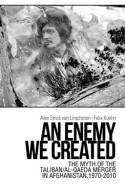An enemy we created
the myth of the taliban/al Qaeda merger in Afghanistan, 1970-2010
- ISBN: 9781849041546
- Editorial: C. Hurst & Co. Ltd.
- Fecha de la edición: 2012
- Lugar de la edición: London. Reino Unido
- Encuadernación: Cartoné
- Medidas: 24 cm
- Nº Pág.: 320
- Idiomas: Inglés

To this day the belief is widespread that the Taliban and al-Qaeda are in many respects synonymous, that their ideology and objectives are closely intertwined and that they have made common cause against the West for decades. Such opinions have been stridently supported by politicians, media pundits and senior military figures, yet they have hardly ever been scrutinised or tested empirically. This is all the more surprising given that the West's present entanglement in Afghanistan is commonly predicated on the need to defeat the Taliban in order to forestall further terrorist attacks worldwide. There is thus an urgent need to re-examine the known facts of the Taliban-al Qaeda relationship and to tell the story of the Taliban's encounter with internationalist militant Islamism, which is what Alex Strick van Linschoten and Felix Kuehn set out to do in An Enemy We Created. Their book also responds to the overheated rhetoric that sustains a one-sided interpretation of the alleged 'merger' between the two groups as well as the policy implications for Afghanistan that flowed in the wake of its acceptance by Western governments and their militaries. The relationship between the two groups and the individuals who established them is undeniably complex, and has remained so for many years. Links between the Taliban and al-Qaeda were retained in the face of a shared enemy following the invasion of Afghanistan after the September 11 attacks, an adversary that was selected by al-Qaeda rather than by the Taliban, and which led the latter to become entangled in a war that was not of its choosing. This book is the first to examine in detail the relationship from the Taliban's perspective based on Arabic, Dari and Pashtu sources, drawing on the authors' many years experience in southern Afghanistan, the Taliban's heartland. They also interviewed Taliban decision-makers, field commanders and ordinary fighters while immersing themselves in Kandahar's society. Van Linschoten's and Kuehn's forensic examination of the evolution of the two groups allows the background and historical context that informed their respective ideologies to come to the fore. The story of those individuals who were to become their key decision-makers, and the relationships among all those involved, from the mid-1990s onwards, reveal how complex the interactions were between the Taliban and al-Qaeda and how they frequently diverged rather than converged. An Enemy We Created concludes that there is room to engage the Taliban on the issues of renouncing al-Qaeda and guaranteeing that Afghanistan will deny sanctuary to international terrorists. Yet the insurgency is changing, and it could soon be too late to find a political solution. The authors contend that certain aspects of the campaign in Afghanistan, especially night raids and attempts to fragment and decapitate the Taliban, are transforming the resistance, creating more opportunities for al-Qaeda and helping it to attain its objectives.






